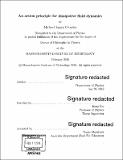An action principle for dissipative fluid dynamics
Author(s)
Crossley, Michael James
DownloadFull printable version (9.577Mb)
Other Contributors
Massachusetts Institute of Technology. Department of Physics.
Advisor
Hong Liu.
Terms of use
Metadata
Show full item recordAbstract
Fluid dynamics is the universal theory of low-energy excitations around equilibrium states, governing the physics of long-lived modes associated with conserved charges. Historically, fluid dynamics has been formulated at the level of equations of motion, in terms of a local fluid velocity and thermodynamic quantities. In this thesis, we describe a new formulation of fluid dynamics in terms of a path integral, which systematically encodes the effects of thermal and quantum fluctuations. In our formulation, the dynamical degrees of freedom are Stuckelberg-type fields associated to the conserved quantities, which are subject to natural symmetry considerations, and the time evolution of the path integral is along the closed-time contour. Our formulation recovers the standard hydrodynamics, including the expected constraints from thermodynamics and the fluctuation-dissipation theorem, as well as an additional non-linear generalization of the Onsager relations. We demonstrate an emergent supersymmetry in the "classical statistical" limit of our theory. For the non-linear fluid, the formalism is encoded in a non-trivial differential geometric structure, with a non vanishing torsion tensor required to recover the correct physics of the most general fluid. Finally, we discuss progress in obtaining a holographic derivation of the action formulation at the ideal level, in which the low energy degrees of freedom emerge naturally as the relative embedding of the boundary and horizon hypersurfaces.
Description
Thesis: Ph. D., Massachusetts Institute of Technology, Department of Physics, 2016. Cataloged from PDF version of thesis. Includes bibliographical references (pages 193-199).
Date issued
2016Department
Massachusetts Institute of Technology. Department of PhysicsPublisher
Massachusetts Institute of Technology
Keywords
Physics.